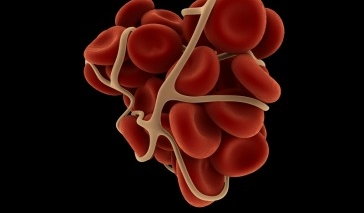Blood clots are created by the body to stop bleeding. Healthy formation of blood clots involves both the building up and breaking down of the clots. If either the breakdown or buildup mechanism is thrown off, a blood clotting disorder can result. Clotting disorders can be acquired or inherited.
- Acquired clotting disorders develop as a result of disease, injury or some types of hormone therapy.
- Inherited clotting disorders are rare, and are passed down from parent to child.
Your doctor can treat bleeding disorders with a variety of medications, including blood thinners.
How do blood clots form?
Blood clots are generally created by the body in response to an injury, to prevent the body from bleeding. In order to form a clot, the blood must contain platelets (thrombocytes) and clotting factors. Platelets are involved in congregating along the site of the wound and forming the “plug” in a clot. Clotting factors are proteins involved with changing the blood from liquid to gel form (coagulation). Clotting disorders can occur if there are insufficient platelets, clotting factors, or if either ingredient is not working properly.
Hereditary clotting disorders are caused by either a lack of anti-clotting factors in the blood, or too much pro-clotting factors in the blood.
Types of clotting disorders
There are several clotting disorders caused by the lack of anti-clotting factors in the blood.
- Factor V Leiden is the most commonly inherited blood disorder, caused by a deficiency of Protein C (a blood factor which contributes to clotting). Factor V Leiden causes an increase in abnormal clot formation.
- Prothrombin Gene 20210A mutation causes abnormally high levels of prothrombin. Prothrombin is a precursor to the enzyme thrombin, which is involved in converting fibrinogen to fibrin, fibrous particles in the blood involved in blood clotting. High levels of prothrombin cause an increase in abnormal clotting. This disorder usually presents itself after trauma, surgery, pregnancy or hormone therapy.
Abnormality in other components of the blood can also manifest in blood disorders, such as elevated levels of fibrinogen (or lack of fibrinogen), elevated levels of Factor VIII, IX and XI (blood proteins), and elevated levels of homocysteine (an amino acid in the blood.)
Antiphospholipid antibody syndrome is a genetic disease in which the body mistakenly attacks normal blood proteins, causing abnormal blood clots to form.
Acquired clotting disorders develop as a result of disease, injury or some types of hormone therapy. Heparin Induced Thrombocytopenia is rare but serious disorder which develops as a side-affect to using heparin (a blood-thinning medication). Work closely with your doctor to monitor your blood-thinning and other medications.
Blood clot disorders: treatments and prognosis
Once a blood disorder is identified, treatment is usually necessary only during a bleeding episode or during surgery.
- Anticoagulant medication is commonly used to treat clotting disorders. Anti-coagulants help prevent blood from coagulating and prevent blood clots from forming. Careful monitoring is required of any patient taking blood thinning medication.
- Thrombolytic therapy is a therapy which dissolves dangerous clots, and is commonly used during an ischemic episode (stroke). Clot dissolving medications are administered directly to the blood clot via injection or catheter. Because patients have to be carefully monitored during this procedure, it is often given in the intensive care unit of a hospital, or in a nursing unit.
Your doctor will encourage you to be at your physical best by maintaining a healthy weight, nourishing your body with healthy foods, getting regular exercise, and avoiding smoking.
Signs of a clotting disorder
Blood disorders are present in nearly every case of deep vein thrombosis (DVT) a condition in which clots form in the deep veins. If clots break off in the deep veins and travel to the lungs, pulmonary embolism (PE) can form. PE can be life-threatening. In the case of PE, the abnormal blood clots symptomatic of some bleeding disorders are dangerous because they can travel to the brain, lungs, or heart. Patients with blood clotting disorders should look out for signs of stroke, heart attack or pulmonary embolism.
Seek immediate medical attention if you see any of these signs:
- Shortness of breath
- Pain or pressure in your chest that won’t go away
- Pain radiating down your shoulder, arm, back, or jaw
- Sudden loss of speech or double vision
- Numbness in your face, arm, or leg
Blood clotting disorders affecting the legs, feet and less commonly the arms, may appear as swelling (edema), redness, wounds that won’t heal (stasis ulcers), or excessive bleeding. A majority of patients with DVT have blood clotting disorders, so any signs of DVT point to a high risk of blood clotting disorder.
Diagnosing blood clots
After a taking a thorough medical history and performing a physical exam, your doctor can order various blood tests to determine whether you are at risk for a clotting disorder, or if the disorder is active.
- Complete blood count (CBC) is often used as a baseline blood test, and can reveal abnormalities on the blood.
- The PT-INR test (prothrombin time) is often given to patients taking coumadin, and it tests the how quickly your blood is clotting. The aPTT (activated partial thromboplastin time) test is given to patients taking heparin, and it also measures the time it takes for blood to clot.
Blood clotting disorder risk factors
Several factors increase your risk of clotting disorders
- Family history of clotting disorders
- Genetic predisposition
- Abnormal blood clotting at a young age (under 50)
- Diabetes or kidney disease
- Atherosclerosis
- Arrhythmia of the heart (abnormal heartbeat)
- History of stroke
- History of miscarriages
- Sedentary lifestyle
- Obesity
- Smoking


